Basic data on the customer address #
To enter a new customer address, click on +New in the top bar.

Enter the data in the screen that appears. The mandatory fields are marked with a red star. When creating and mutating the address, only basic fields or fields with entered data are displayed. To show all fields, select the Show all fields checkbox.
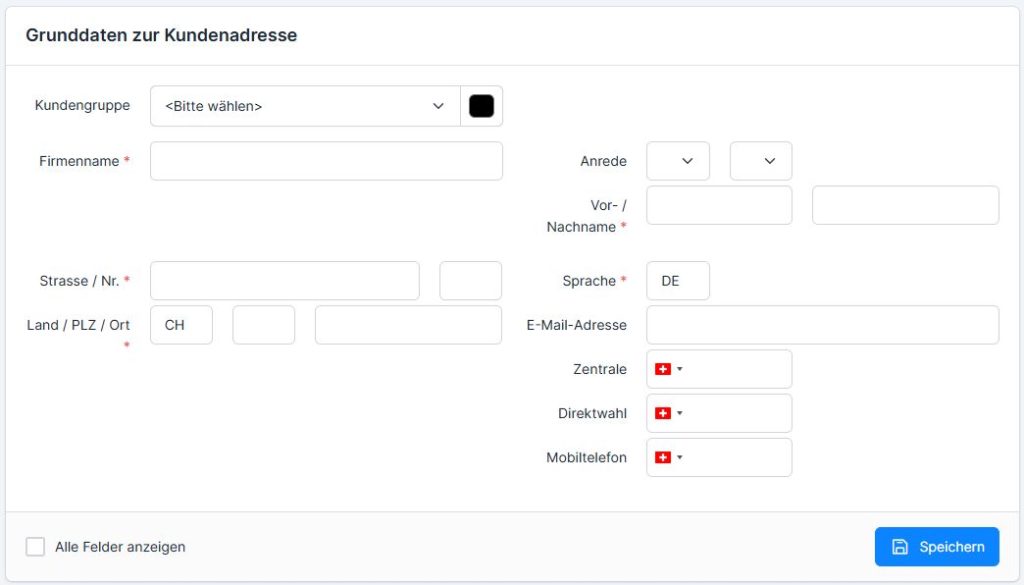
The addresses entered have several tabs (basic data, properties & assets, conditions & offers, orders & invoices, documents and diary), which can be switched between under the contact name.

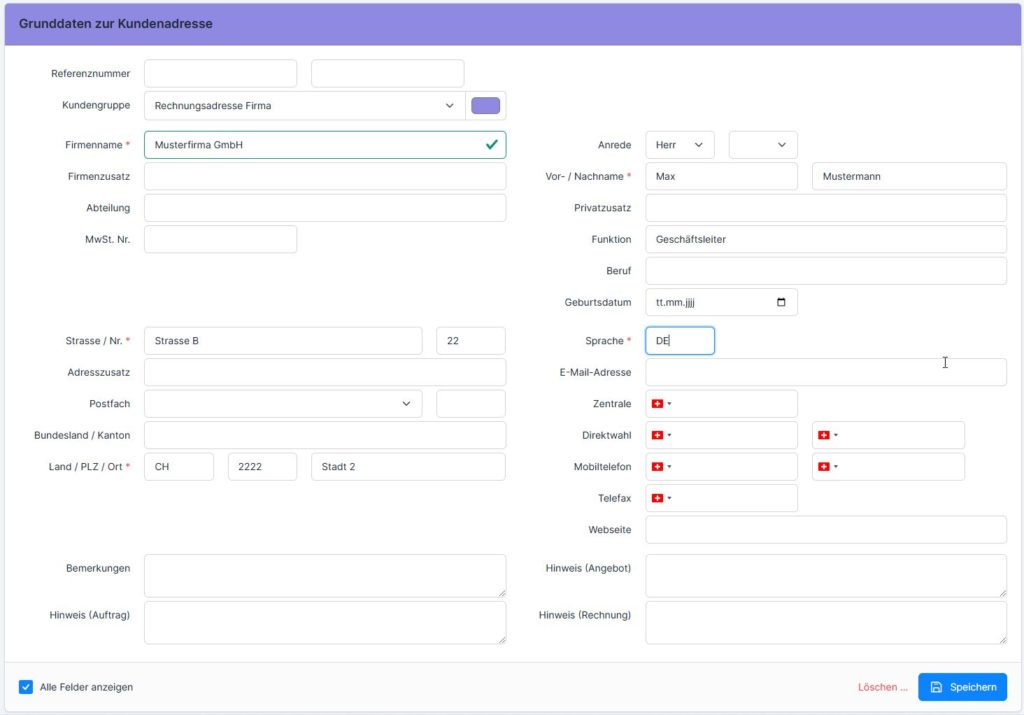
Customer group #
The fields of the basic data vary depending on the type of customer group set:

This selects the contact type: Here as an example – internal address, group structure, customer contact /employee of customer/, employee address /employee of own company/, object address /e.g. construction site address/, invoice address company /if the counterparty is a company/, invoice address private /if the counterparty is a private person/ and others.
Address groups can be edited / added / deleted: Customer addresses → Three-dot menu top right → Settings → Customer address groups. Address groups “Company billing address” and “Private billing address” cannot be deleted (system groups). You can find out how to store the icons for the individual groups here: Images, logos and symbols (icons).
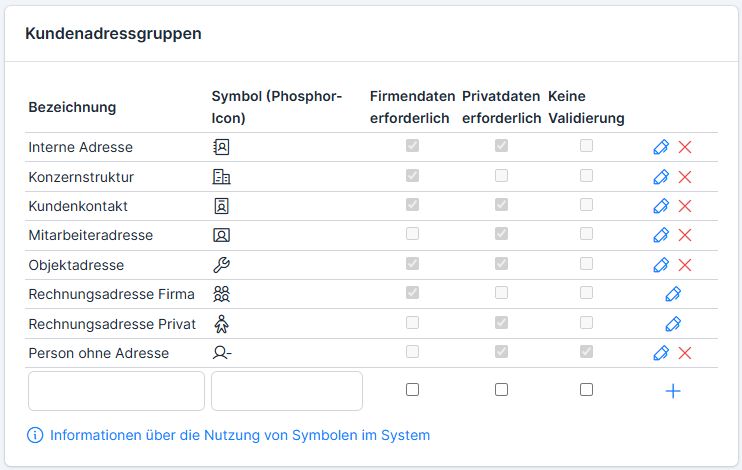
The setting “Company data / private data required” checks whether the mandatory data has been filled in when saving a new customer address. The “No validation” setting allows a new address to be saved without a data check.
Further information on customer groups can be found here: Difference between customer groups, properties, authorization roles and relationships
Reference numbers / codes #
Each customer address automatically receives the consecutive ems (system) internal number. You can also enter two of your own customer numbers/codes. By default, only one field is displayed for the reference number.

The 2nd reference number is activated in the settings.

The search for the 2nd reference number is only possible if it is activated.
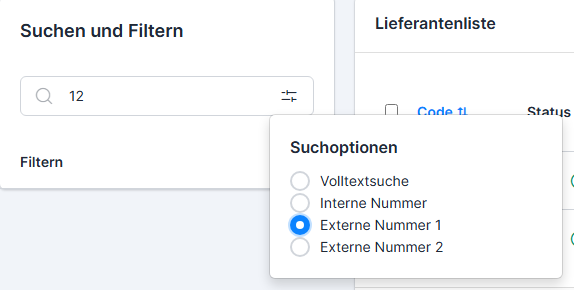
In the address overview, the 1st reference number is displayed in addition to the system code.
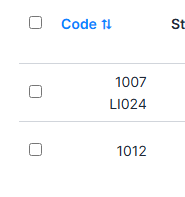
Color highlighting #
Each address can be highlighted in color. To do this, click on the button to the right of the customer group and select the desired color in a suitable way:
- by moving the bar
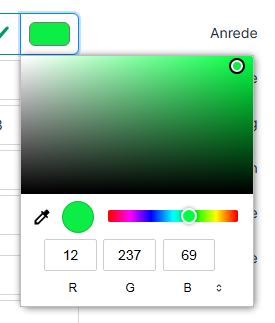
- using the eyedropper tool (click on it, move the magnifying glass tool that appears to the desired color on your screen and click again to select)
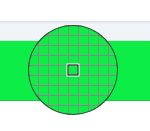
- by specifying RGB/HSL/HEX data – you can switch between these input options.

The set color is used to mark the address.

The color coding is used for the customer address in the customer address list as well as for the customer address in the order / offer / invoice in this color.

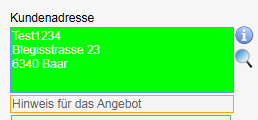

Salutation and title #
The salutation and title are displayed for selection in the language of the logged-in user. Our system currently supports nine different languages. For export lists (address lists), the language of the salutation is determined based on the customer language.
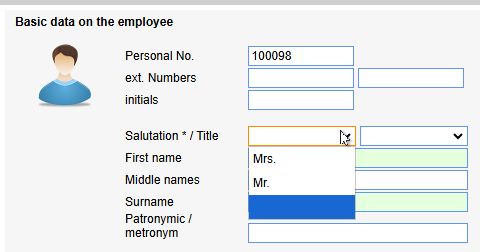
Tips for further basic data #
- Street / No. – The house number is automatically transferred to its own field
- Address addition – e.g. additional street for the house at the intersection
- Federal state / canton, country / town, language – if specified, the addresses can be filtered according to this property
- Language – the documents to be sent to this contact that are created in the system (such as invoices, checklists, etc.) are automatically sent in this language
- Switchboard, direct dial, cell phone, fax – the country code of the country specified when the system is set up is used by default
- Cell phone – the system checks that the area code corresponds to the format of a cell phone number
- Website – must start with http:// or https://
Remarks and notes #
When entering a new customer address, you can enter important remarks and notes that should be taken into account when creating quotations, customer orders and invoices.
- Remark – e.g. what the company does or special information about the employee
- Note (offer) – appears in the offer under the customer addresses – what must be taken into account when preparing the offer
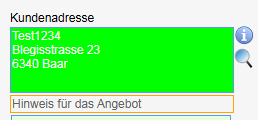
- Note (order) – appears in the order under the customer addresses – a note for order entry/processing
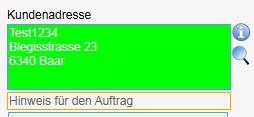
- Note (invoice) – appears in the invoice under the customer addresses – a note for future invoicing
Error during data entry #
The system checks the data entered. If the entered value/text can be accepted, a green tick appears

If an unacceptable value is entered, a message appears when saving:

The URL of the website must begin with http:// or https://:

An error message appears for some fields (e.g. the zip code length, which is checked depending on the country selected).

If the data has been entered correctly, the system will inform you with a green message when saving.

Relationships between addresses #
The addresses can be linked to each other via the relationships. This allows you to create address networks. You can read more about this here: Customer networks
Select the relationship types for the open address 1 (e.g. shareholder) and the address 2 to be linked (e.g. company), then use the three-bar menu to find the address 2 from the address book (customer address, supplier address or employee) or create a new customer address(+ New customer address). You can leave a comment in the Comment field.

In the next screen, find the desired address and click on the arrow button.

The saved relationships can be changed using the pencil button.
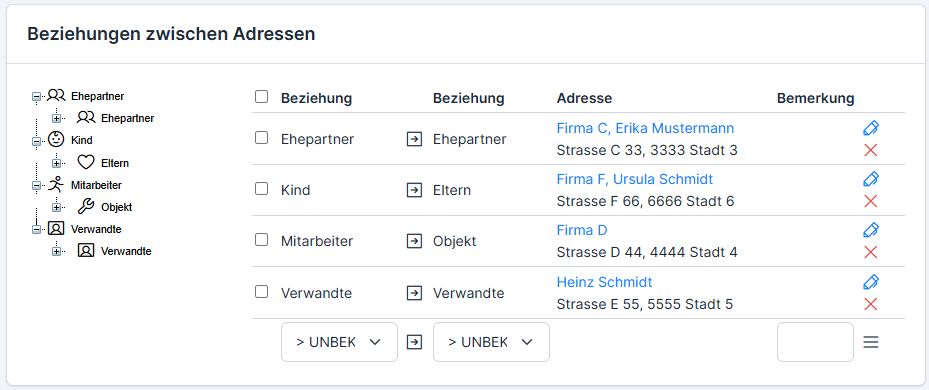
Further information on relationships can be found here: Difference between customer groups, properties, authorization roles and relationships
Manage relationship types #
The relationship types are managed in the settings.
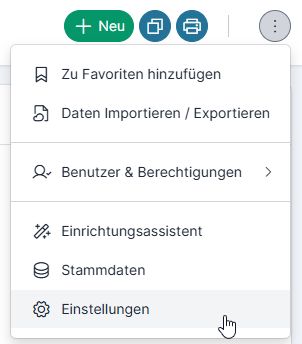
Existing relationship types can be deleted and new ones added. The phosphor icon can be stored in the Symbol column – a symbol that appears in front of the address (more on this here: Images, logos and symbols (icons)), in further columns you tick the address groups for which the relationship type can be applied and click Plus to save.
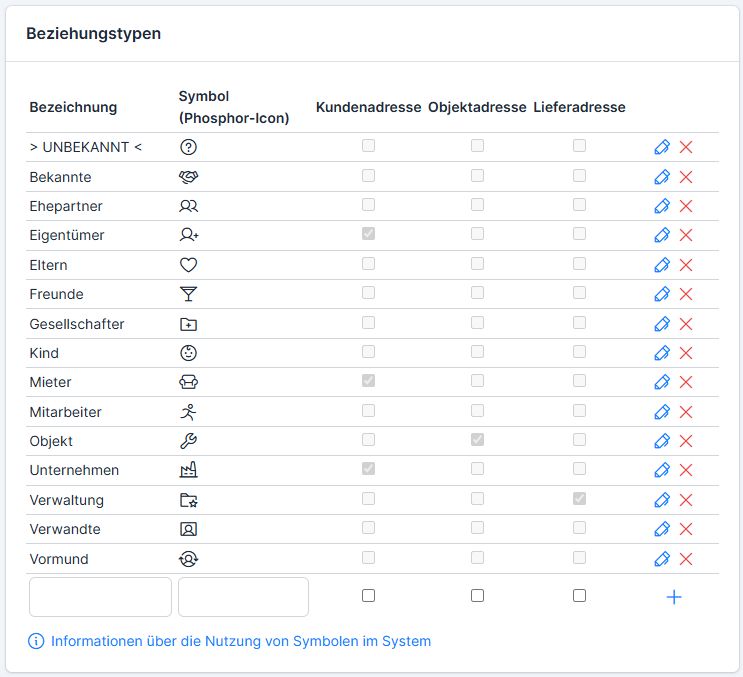
It is possible to filter the customer addresses according to the relationships. You can read more about this here: Manage customer addresses (section Filter by relationships)
Campaigns #
Campaigns in which the customer has participated or been involved.

Campaigns are managed via Customer Relationship → Marketing & Communication.
Read here how campaigns can be run easily and efficiently via the Mailjet mail platform: Mailjet connection (for campaigns)
Properties & Assets #
- Assign the property to the contact (so that the search for the contact property is possible – it does not matter whether it is activated/checked or not).

Add extended properties to the customer address #
Extended properties can be added for the customer addresses (contact category /authority, bank etc/, sector, special types of contacts, membership of associations or affiliation to certain structures etc). You can use these to activate properties that can be used to simplify the search. Further information on properties can be found here: Difference between customer groups, properties, authorization roles and relationships

In order for a property to be selected, it must first be stored in the settings(Customer addresses → Three-dot menu top right → Settings → Additional properties);
The properties can be stored for 3 objects: 1 – customer addresses, 2 – employee addresses, 3 – supplier addresses. The three checkboxes in front of the property correspond to these 3 objects. Depending on which checkbox is activated, the property appears in the property search of the object.

When the property is stored, the object category is set automatically, depending on which module was used to open the settings.
The property can contain a name (upper field – group name, lower field – name of the property), the type (can be supplemented with a default value or a selection list) and a unit for certain types (integer and decimal number).
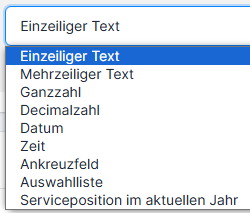


Registrations #
In the Logins area, the access data for customers is managed, with which they can gain access to the ems system. Click on the plus button to create a new login. To change the existing password, click on the three-bar button.

At the moment, you can log in with a login password, a Microsoft and a Google account.
If the “Change password on first login” option is activated, the user is prompted to reset the password the first time they log in.
The option “Send access data to this e-mail address” sends the stored access data to the specified e-mail address.
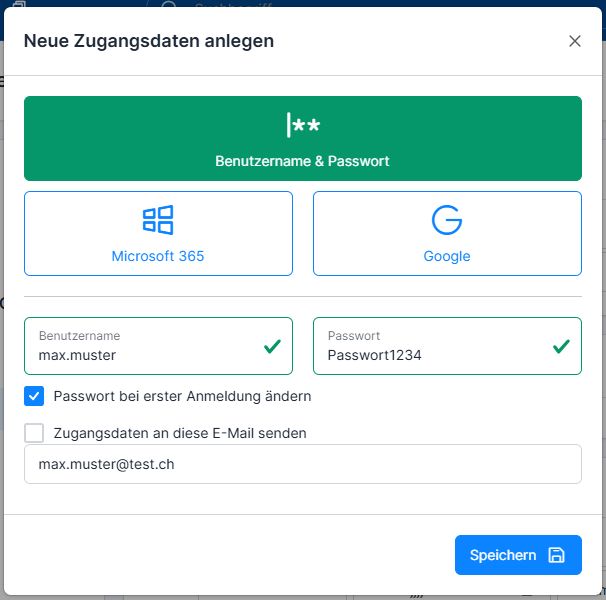
All customer logins that have been created and entered can be found in the User overview list. This can be found via Customer addresses → Three-dot menu top right → Users & authorizations → User overview.

To filter out customers, select the corresponding checkbox Customer addresses.
Assignment of the role to employees, customers or suppliers #
Registration enables access; the authorization role defines the data to which the customer / partner has access.
The corresponding authorization role is assigned here (you can find out how the authorization roles for customers are stored here: Authorization roles for customers).
Further information on authorization roles can be found here: Difference between customer groups, properties, authorization roles and relationships
Conditions & offers #
Conditions & agreements #
Conditions and agreements of a financial nature can be stored here, e.g. customer discounts.
The discount groups are stored in the master data(Customer address → Three-bar menu top right → Master data → Discount groups).
Settings for offsetting #
Contracts with the customer, which are used for invoicing.

Settings such as company code (conditions), invoice type (CH03, CH01, CHQR) and e-mail addresses for invoice delivery are made in the billing settings.
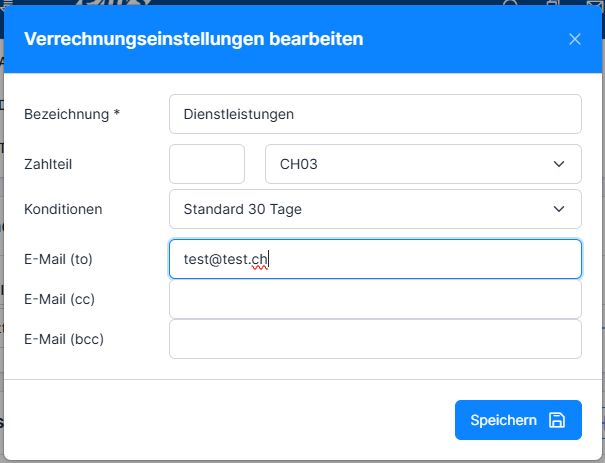
Offer list #
The quote list contains all quotes that have been created for customers. The plus button opens the screen for a new quote.

Orders & Invoices #
Sales orders #
Sales orders that have been issued with the customer address.
Ticketing #
Tickets that the customer has created or that have been created for the customer.
Sales order list #
Customer orders containing the customer address.

Customer invoice list #
Invoices that have been issued to the customer.

Documents for the customer address #
You can store any number of documents for each customer address. To do this, use Drag&Drop or Select. You can enter the URL for the file in the field to the right of Drag&Drop.
If the Overwrite files with the same name checkbox is active, a document with the same name will replace one that has already been uploaded. It is suitable for updating files.
Store templates #
If you would like to upload a document as a template in which the supplier address data is automatically integrated, you can upload this under Templates . You can find out how to work with the templates here: Document templates

Customer address diary #
The diary allows you to enter reminders and appointments for employees and yourself for customers. Set the appointment, select the employee responsible and describe the task, then click Plus to save.


The employee sees this task on their web homepage.
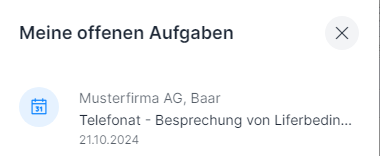
If you want to show the system entries, deactivate the Hide system entries checkbox. (System entries are automatically created log entries that document system activities and events. These can include system messages or automatic changes, for example. By activating the “Show system entries” checkbox, you can gain insight into the system-side actions).
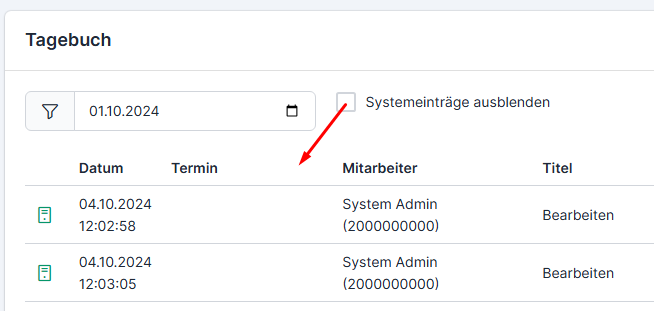
If the task has been completed and released, it is highlighted in green.

If the date of the task is overdue, it is highlighted in orange.
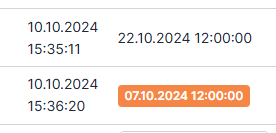
Read more about changing and managing customer addresses here: Manage customer addresses